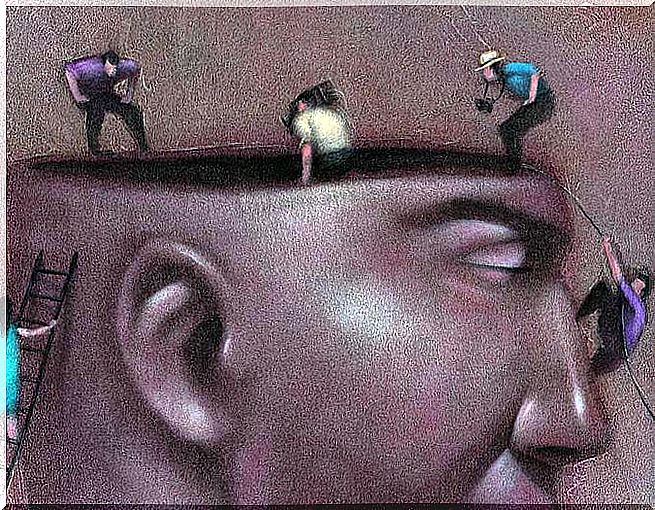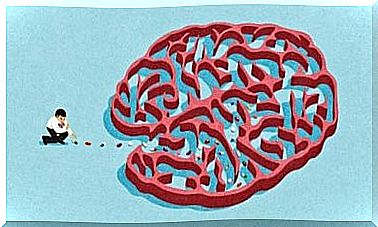The Art Of Self-Deception

The art of self-deception refers to situations where we lie to ourselves. In fact, it is our brain that tricks us. Self-deception occurs when we convince ourselves that something is true when it is not, but we do it unconsciously.
The difference between lying and self-deception is that with lies, the person is aware that he is not telling the truth. While with self-deception, people unknowingly convince themselves that a lie is actually the truth.
In other words , the self-deceived person does not realize that he is doing it, or at least he does not always realize it, and that is precisely where the power of self-deception lies. As long as we do not understand it, self-deception will show its power; in its own quiet, hidden way.
There are different types of self-deception, some are more frequent than others. In addition, each of them has different psychological effects. We will explain the four most common types of self-deception and their most important psychological effects.
1. The art of self-deception: Functional self-deception
We observe functional self-deception in situations where the person is lying and trying to convince himself that his decision is right. The best-known example of functional self-deception is found in Aesop’s fable The Fox and the Grapes.
In this fable, the fox, characterized by its cunning, is attracted to a juicy bunch of grapes and tries to reach it by jumping up several times. After a few unsuccessful attempts, the fox stops trying and manages his frustration by deceiving himself. He convinces himself that he did not want the grapes anyway, and that they were not ripe enough.
The self-deception described in the fable of the fox and the grapes is called functional self-deception. This has a very clear function (hence the name): the act of lying to oneself is useful to the fox, because it avoids the irritation that comes from defeat by not reaching those grapes.

The problems of functional self-deception
Short-term functional self-deception can serve a purpose, but in the long run it is neither positive nor beneficial. The psychological effect is achieved because the person decides to turn a truth (not being able to reach a goal) into a lie that reassures him (the goal is not worth it).
According to psychologist Giorgio Nardone, any good intention, if repeated too much, becomes negative and counterproductive. In other words, anything that is functional, if prolonged too much or taken in large doses, gives the opposite effect of the desired one.
In this way , the person who uses functional self-deception is never challenged, and remains constantly within their comfort zone. Because, instead of training himself to try to get the necessary skills to reach his goal, he continues to lie to himself. He convinces himself that what he really wanted is actually not that important, or that it is not worth all the effort required of him to reach his goal.
2. Value and belief
The self-deception called “value and conviction” stems from the need to end a conflict over desires. This type of self-deception is characterized by the belief that if something costs a lot of money, time or effort then it is worth more than something we have not paid that much for. For example, we value belonging to a group that was difficult for us to get into, more than any other group that was not.
In situations where a person has to work hard to reach a goal, whether the goal is attractive or not, their attention leads them selectively towards anything that confirms that their goal is valuable. They end up believing that the goal is valuable in justifying the investment they have made in it. If not, the conflict over desires as we mentioned above will show its ugly head.
Where does this self-deception come from?
Because we as humans cannot maintain the discrepancy between our cognitive system (beliefs, thoughts and ideas) and our behavioral system (actions, behaviors) for a very long time, the “value and belief” self-deception arises as a way of solving the paradox.
The main psychological effect of this self-deception is that the person struggles to reach a goal that often does not fit into their system of principles and values. It is a self-deception that has an expiration date because its effect does not last forever. In the long run, the person usually ends up becoming aware of this deception and feels disappointed.
3. Comforting self-deception
Comforting self-deception is the wisest of all, and is often observed in jealous people. Consoling lies are observed in situations where the person blames something or someone else for their situation, in order to feel sorry for themselves.
Some examples of comforting self-deception would be to think that you have a phobia because your mother “scared you dogs” or to think that “I am a very jealous person, because my partner gives me reasons to be like that”. These are thoughts that a person often thinks about to find comfort.

In this way , the comforting self-deception protects our self-esteem and our ego. It makes us believe that nothing is our fault and that we are always the victim. In a way, this is positive, as in many situations we are not 100% responsible for the circumstances we are in. But on the other hand, emphasizing previous causes and external factors will make us resist the changes we have to do in our lives.
The pitfalls of comforting self-deception
Consoling lies protect us. The problem with any form of long-term protection is that it prevents us from growing psychologically. The psychological effect of this self-deception is that it prevents us from tackling the problems that make us feel bad and assures us that it is impossible to overcome them.
4. Lying to others to convince yourself
One of the most subtle ways to deceive yourself is to lie to others, and thus also to lie to yourself. These are situations where the person conveys stories, situations and perceptions that are distorted. At first he is aware of this slight distortion of the truth, but little by little the person ends up being absorbed in his story and the characters involved.
If this lying mechanism is repeated several times, the lie becomes the truth – even for those who created it. One possible explanation for this phenomenon is that the brain adapts to dishonesty and the lie is lived as a reality. It is as if the person has forgotten that they have invented everything. Even in the light of clear evidence that it is a lie, these individuals manage to continue to deny reality, not because of a lack of honesty, but because of self-deception.
No one is immune to this kind of deception. It is a very frequent psychological phenomenon and, to some extent, quite common. Freeing yourself from your own lies requires a lot of personal reflection. Looking at yourself and understanding your own values, ideals and desires is the first step towards protecting yourself from self-deception and focusing on goals that you really want to achieve.









